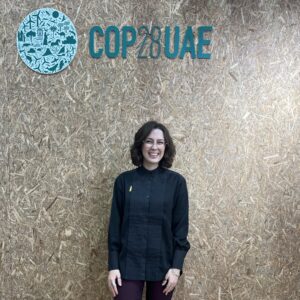Charlotte Morrison, Systems & Optical Engineer at TAS, writes about her experiences at COP28 with Space4Climate – would you have asked the same questions?
Three COP28 Volunteers joined Space4Climate in Dubai in December 2023. Their role was to support on organisation for our four events at COP28 and to greet and engage with the hundreds of visitors to our stand. Their involvement was made possible by the UK Space Agency supported by Space4Climate, the National Centre for Earth Observation and the volunteers’ own organisations. Here, Charlotte Morrison, Systems and Optical Engineer at Thales Alenia Space, writes about her experiences, picking out three of the questions she was most frequently asked on the Space4Climate stand at COP28:
Attending COP28 was an amazing experience and gave me the opportunity to talk to people from all walks of life. Financiers, ministers, negotiators, space industry professionals, school children and families all visited the Space4Climate stand and our experts were asked a multitude of questions. However, there were some questions that came up again and again. Here are some of our most frequently asked questions (and answers) for those who were not able to join us in Dubai.
Is space data accurate enough?
When a space climate mission is launched its instruments and payloads are thoroughly characterised and calibrated. The test campaigns take months and ensure that the instrument performance is well understood. Missions are designed with a specific lifetime in mind and significant effort is put into modelling the instrument so potential performance changes are characterised. However, the environment in space is severe and the initial properties of instruments do change, which can affect the data.

This is where the TRUTHS mission will come in. TRUTHS (or Traceable Radiometry Underpinning Terrestrial and Helio Studies) will not only carry a spectrometer for measuring the incoming solar radiation and how it is reflected by the Earth, it will also have an on-board calibration system. This allows TRUTHS to function as an in-orbit reference standard. This has the potential to increase other missions’ accuracy by 10 times.
The TRUTHS mission was conceived by the UK’s National Physical Laboratory (NPL), will be built by AIRBUS UK and use the Teledyne e2v Chroma detector. At COP28 there was a very exciting event where ESA, AIRBUS and Teledyne e2v signed the contract for initial phases of the TRUTHS mission development. COP28: UK climate satellite contracts – GOV.UK (www.gov.uk)
How much Biomass is there?
Biomass (organic matter) was a hot topic at COP28. There were a number of talks across the Green and Blue Zones including the monitoring and protection of mangrove trees and our existing forests. The European Space Agency (ESA) is currently preparing to launch a mission dedicated to this topic – the Biomass climate satellite – conceived by Prof Shaun Quegan of the National Centre for Earth Observation and University of Sheffield, who is the mission science lead.
The goal of the Biomass mission is to track global biomass and carbon storage in the world’s forests as part of the ESA Earth Explorer programme.
It will improve the resolution of current space-based biomass instrumentation to 200m above forest canopy and 50m above forest clearings.
Not only will this mission empower us with the tools to track biomass, but it will be another tool for tracking deforestation.
For more information on the BIOMASS mission before its imminent launch, go to Biomass – Earth Online (esa.int) and watch the Space4Climate explainer video here.

What about the pledges and promises?
Many of our stand visitors were concerned with how companies and governments can be held accountable for the promises and pledges made at COP28. Thankfully, space has the perfect tool set for making these assessments. Space agencies around the world are designing specific missions to feed into the Global Carbon Stocktake in 2028. The UK and French space agencies, for example, have combined forces to create the MicroCarb mission. This is a carbon monitoring mission that was assembled and tested by Thales Alenia Space UK will launch this year. For more information on the specifics of the mission, go to MicroCarb | MicroCarb (cnes.fr)

